A new study shows that one easy diet change can end annoying nighttime bathroom trips.
After age 50, most people wake up one or more times a night to urinate. This is a condition called nocturia. It can lead to sleep disruption, daytime tiredness, irritability, and stress.1
Most people with this problem are told to reduce the amount of water they drink before bedtime. But drinking plenty of water is important to good health. And the new research reveals there may be another, more effective strategy.
Scientists at Nagasaki University in Japan gathered over 300 adults at least 45 years of age. They all had nocturia.
The subjects were divided into two groups. One group reduced their salt intake from 11 grams to 8 grams a day. The other group consumed 11 grams of salt every day.
Recommended for You: Men: How many times do you get up at night to pee?
Those bed-to-bathroom marathons leave you worn out and frustrated in the morning…and don’t let up during the day either. You know it’s your prostate, and you’ve tried everything—until now.
This easy solution helps put an end to that constant “gotta go” feeling by getting to the root of what causes it. In one study, men cut their combined daytime and nighttime bathroom trips by more than 50%—and boosted their flow. All the details, and how you can try it, are right HERE.
Eleven grams of salt contains about 4,400 mg of sodium. Eight grams of salt has about 3,200 mg of sodium.2
After 12 weeks, the reduced-salt group cut their number of nighttime bathroom trips almost in half. They went from an average of 2.3 trips a night to 1.4.
Meanwhile, the control group needed to use the bathroom more frequently. They went from 2.3 bathroom visits a night to 2.7.3
Dr. Tomohiro Matsuo is a urology professor at Nagasaki University. He led the research. “This simple dietary modification might significantly improve the quality of life for many people,” he said.
The study “is the first study to measure how salt intake affects the frequency of going to the bathroom,” said Dr. Matsuo. It was presented recently at the European Society of Urology annual meeting in London.4
6 Sneaky Sources of Salt in Your Diet
To reduce bathroom trips, you don’t have to deprive yourself. You can still eat salty foods. The 3,200 mg of sodium used in the study is far from a “low-salt diet.” Most of those allow only about 1,500 mg.5
Instead, do your health a favor and cut out junk foods. Americans get 75% of their salt from processed and fast foods.6 By eliminating these, you’ll not only wake up less at night, your overall health will improve.
Here’s where salt is hiding in your diet:
Condiments. Ketchup, commercial mustards, barbeque sauce, steak sauce, anything pickled, and store-bought dips are all loaded with salt.
Cheeses. Lots of salt is used in cheese making. The worst offenders are blue, gorgonzola, and Roquefort cheeses.
Canned soups, stews, vegetables. Some soups contain over 2.5 grams of salt (1,000 mg of sodium) per serving. Canned beef stews and chilis are often even higher. Canned vegetables not only are filled with sodium, they have far lower nutrient levels than fresh.
Baked goods. Whether sweet or savory, commercial baked goods are full of salt.
Cured, smoked, or processed meats. A single strip of bacon has over 1.5 grams of salt (620 mg of sodium). Processed meats are among the worst things you can eat.
Fast food. You don’t need us to tell you that you should drop fast food from your diet. It’s bad for your heart, brain, liver, and just about everything else. That fast food burger or chicken sandwich can contain 3.5 grams of salt (1,450 mg of sodium).7
One other thing… Replace the industrial table salt in your shaker with natural sea salt.
Table salt has all the nutrients stripped out of it. All that’s left is sodium and chloride…with some chemical additives thrown in. Sea salt contains dozens of essential minerals. And it tends to be more flavorful. So you’ll use less.8
Like this Article? Forward this article here or Share on Facebook.
References:
1http://www.bbc.com/news/health-39382339
2http://foodwatch.com.au/blog/measures-and-conversions/item/how-to-convert-sodium-to-salt-and-salt-to-sodium.html
3https://consumer.healthday.com/diseases-and-conditions-information-37/urine-problems-news-687/less-salt-fewer-nighttime-bathroom-trips-720959.html
4https://www.ics.org/Abstracts/Publish/241/000009.pdf
5http://www.dashdietoregon.org/why/The-Lowdown-on-Sodium
6http://www.fda.gov/forconsumers/consumerupdates/ucm181577.htm
7https://www.caring.com/articles/top-10-hidden-sources-of-salt
8https://www.institutefornaturalhealing.com/2015/02/5-best-replacements-for-table-salt-they-taste-better-too/

